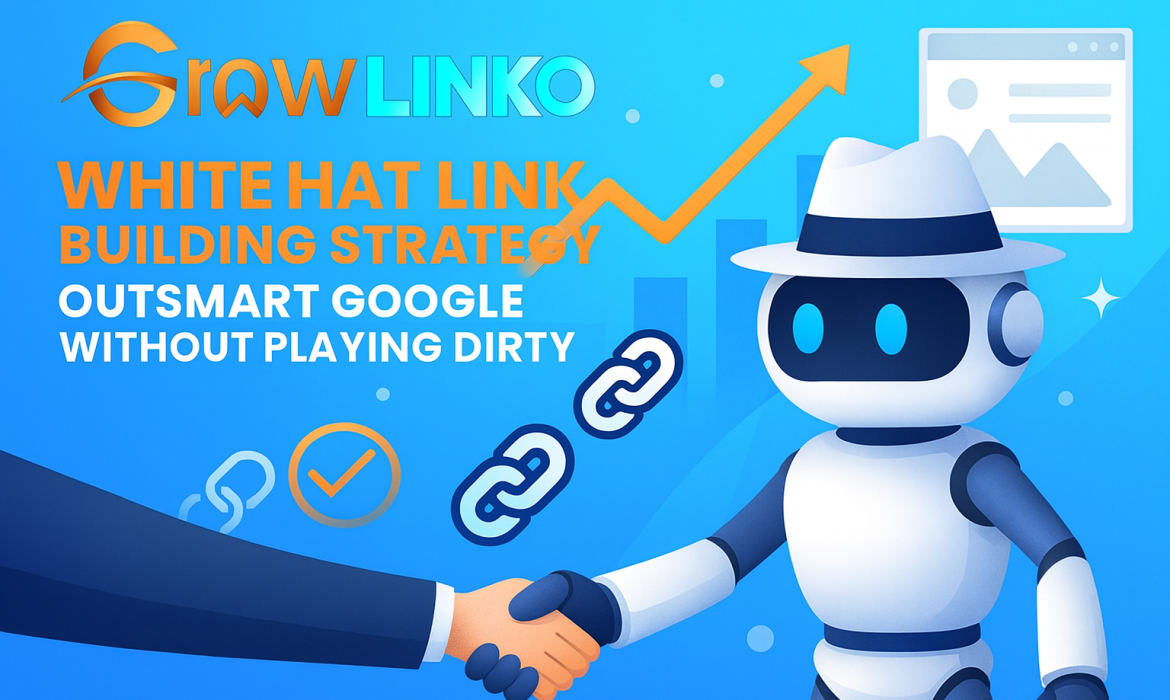
Link building has always played a key role in SEO. It helps your website show up in search results. But not all links work the same. Some help. Some hurt. That’s where strategy comes in. You must choose the right kind of link building to avoid risk and win real results.
Many business owners want quick traffic. They want their site to grow fast. Some turn to shady tricks. They buy links or use automated tools. These methods break search engine rules. The risk is high. One penalty can ruin months or years of hard work. A single mistake can erase your entire online reach.
White hat link building gives you a clean path. It follows Google’s official guidelines for helpful content. It works through effort and value.” This strategy may take more time, but the rewards last. You gain trust. You grow slowly but safely. You build a strong base that supports long-term success.
In this guide, you’ll learn how to apply white hat techniques. You’ll see how to create content that attracts links. You’ll learn how to reach out without sounding fake. Each section gives useful tips in simple words. Let’s dive in and explore what makes white hat link building the right choice for honest growth.
What Is White Hat Link Building?
White hat link building means earning backlinks the right way. You don’t trick the system. You don’t fake it. You create real value. Others link to your work because it helps them or their audience. These links bring lasting results because they reflect trust.
Search engines want to serve the best results. They reward pages that people trust. A backlink tells Google your page matters. When trusted websites link to you, your rankings improve. These links act like votes. The more quality votes you get, the higher you rank.
White hat methods take effort. You write, share, and connect. You build relationships. You offer help. In return, people link to your pages. This method takes time, but it keeps your site safe. You don’t fear penalties. You don’t chase loopholes. You grow with peace of mind.
Real links from good sources raise your authority. That trust spreads. More people visit your site. Other websites find your content and share it too. The growth keeps going. That’s why white hat link building is not just safe, it’s smart.
What Makes a Backlink High-Quality in Google’s Eyes
Search engines do not treat all links the same. Some links pass real value. Others can harm your site. Google focuses on quality, context, and trust. A high‑quality backlink fits naturally into the content and comes from a trusted, relevant source.
Key Qualities of a Strong Backlink
| Quality Factor | Description |
|---|---|
| Relevance | The linking site covers a topic related to your niche. |
| Authority | The site has real traffic, strong domain power, and clean history. |
| Placement | The link sits inside the main body of useful content, not hidden in sidebars or footers. |
| Anchor Text | The linked words sound natural and fit the sentence, not stuffed with keywords. |
| User Value | The page linking to you gives readers helpful information that connects with your topic. |
| Traffic Source | The link appears on a page with real visits and audience engagement. |
| Clean Reputation | The linking site is free of spam, ads, or low‑quality outbound links. |
Avoid These Risky Links
- Random directories or low‑effort link farms
- Blogs that post paid links without disclosure
- Sites unrelated to your topic or niche
- Comment‑section and forum‑signature links
- Pages filled with ads or copied text
Smart Tip
Always check the domain’s trust, traffic, and content before accepting or chasing a backlink. Google rewards links that help readers, not those built only to trick the algorithm.
How Google Evaluates Links in Its Ranking System
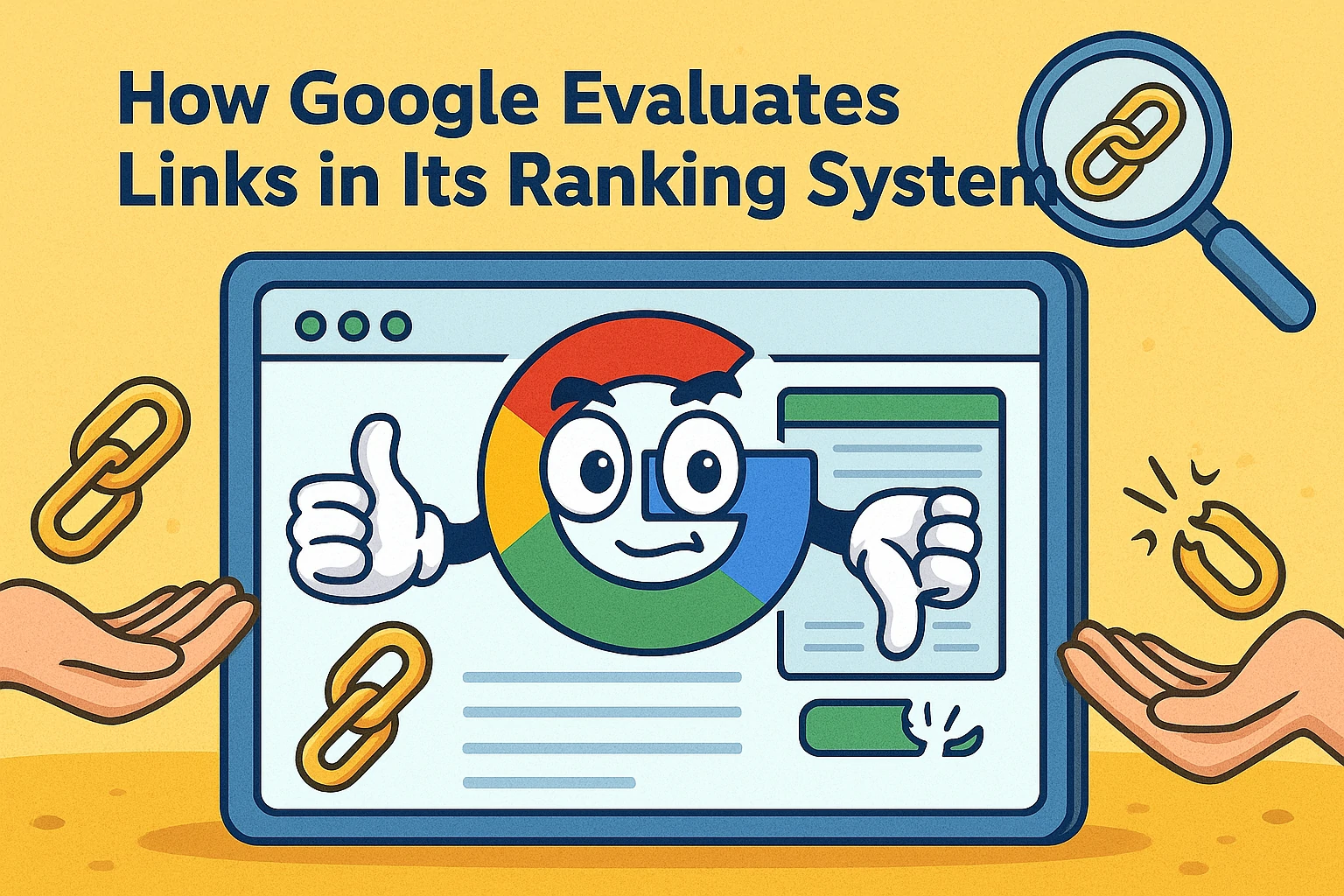
Google judges your backlinks like a talent show, make them impressive or face the SEO gong!
Google uses backlinks as signals of trust. Each link acts like a vote for your website. But not all votes count the same. Google studies how natural a link looks, where it comes from, and what surrounds it. It checks the anchor text, the page quality, and how users interact with the site. If a link seems helpful and organic, it improves your ranking. If it looks forced, Google may ignore or even penalize it.
Search engines follow strict patterns when judging links. They look at how many trusted domains connect to you. They also consider how often those sites update their pages and whether your link adds value to readers. A link from a major publication can do far more than one from an unknown blog. Quality, not quantity, matters most.
Over time, Google also reviews the freshness of links. Older, consistent backlinks from long-standing websites show authority. Sudden spikes from random pages may look suspicious. The goal is to earn a steady flow of relevant, honest links from pages that users trust and engage with.
Why You Should Avoid Black Hat and Stick With White Hat
Black hat SEO means risk. It includes things like buying links, joining link farms, or using hidden text. Some people still use these methods. They want quick traffic. But fast gains often lead to big losses. When search engines catch you, the damage is hard to fix.
Search engines use smart systems. They scan your backlinks. They look at patterns. If they see something unnatural, they act. Your site may drop in rankings or disappear from search results. This can hurt your business overnight.
White hat methods work differently. You don’t rush. You focus on value. You build one honest link at a time. You avoid tricks. You stick with strategies that search engines approve.
Over time, white hat links bring better results. They support your entire website. You build a clean profile that grows stronger each year. Your site becomes a source that others trust. And best of all, you don’t fear a sudden drop in search traffic.
If your brand matters, white hat is the only safe path. You stay visible, respected, and secure.
How to Build Authority Links with Consistent Outreach
Authority links do not come by chance. You must earn them through steady outreach. This means reaching out to real websites, sharing something useful, and following up with care. The more consistent your effort, the more links you gain. Trusted sites only link to you when they see value, respect, and relevance.
Start with a simple goal. Choose one helpful page on your website. Look for websites in your niche that talk about similar topics. Study their writing style. Make sure your content fits their audience. Then write a short, polite message. Keep it personal. Show them why your page helps their readers. Do not ask for a link right away. Focus on starting a real conversation.
Follow up once if they do not reply. Don’t spam. Respect their time. Even if they say no, thank them. Many editors remember people who are polite and honest. Over time, you build a list of contacts. Some of them may link to your work in future posts. This steady approach leads to strong links that last.
How to Write Guest Posts That Actually Get Accepted
Guest posting works well, but only if you do it right. Many people send the same email to dozens of websites. That approach fails. Editors want value, not spam. You must take time to know the site and its readers. A strong guest post pitch starts with research and ends with real results.
Look at the blog’s latest posts. Check the writing style. Read the topics they focus on. Match your content idea to their tone. Write a subject line that makes sense and feels personal. In your email, mention one of their recent articles. Show that you care about their content, not just your link.
Offer a useful idea that their readers will enjoy. Keep your message short and clear. Let them know you can write high-quality content. Don’t make demands. If they say no, thank them and move on. If they say yes, write the post with care. Include real examples, trusted sources, and clear structure. When you give value, your guest posts build trust and backlinks.
Many site owners ask whether to invest in content or links. Learn the difference between the two in our full guide: Guest Post vs Backlink: What’s Better for SEO?
White Hat Link Building vs. Gray Hat: What’s the Difference?
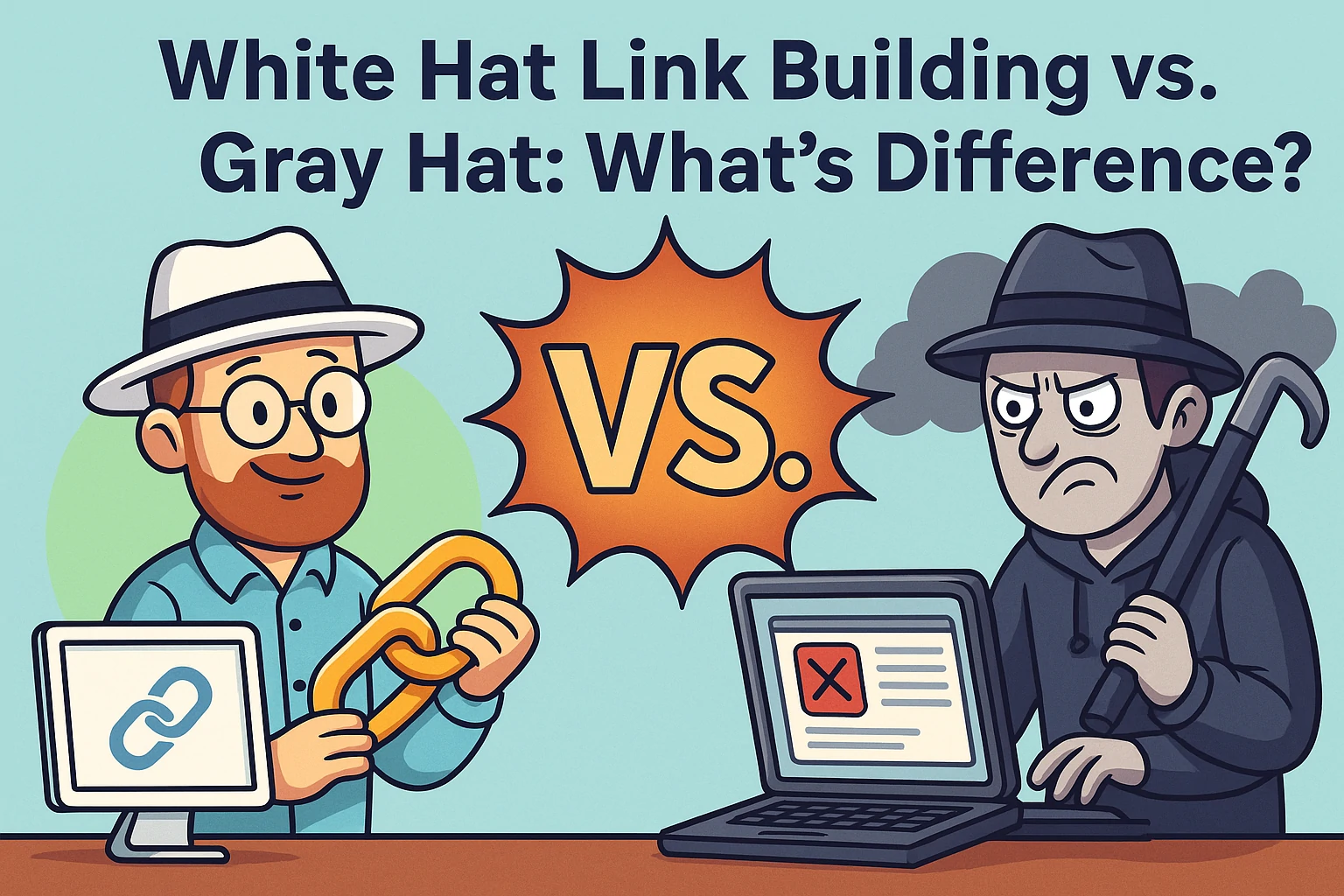
SEO Showdown: The White Hat vs. the Gray Hat
White hat and gray hat may look similar, but the intent behind them is not the same. White hat link building stays within search engine rules. It earns links through honest effort. Every step focuses on value. There is no trick, no shortcut, and no intent to fool the system. These links are safe and respected.
Gray hat link building walks a thin line. It bends the rules but does not fully break them. Some gray hat methods include using link exchanges, creating fake guest posts, or hiding sponsored content without labels. These tactics may work in the short term, but they still carry risk. If Google finds out, you can lose rankings or get penalized.
The key difference is trust. White hat SEO builds trust with search engines and readers. Gray hat may give faster results but often sacrifices long-term safety. If your brand matters, white hat is always the better choice. It protects your site, your future, and your reputation. Shortcuts fade. Trust lasts.
Link Relevance: Why It Matters More Than Quantity
Link building is not about numbers. A single link from the right site helps more than ten links from random pages. Relevance is the key. When the linking site shares your topic, that backlink tells Google your content has meaning. It shows your site belongs in that niche.
For example, if you run a fitness blog, a link from a health magazine means more than a link from a tech forum. The content must connect. The audience must care. That’s how search engines decide the value of a link. Even a smaller site can pass strong value if it stays on topic and shares useful content.
Relevance also helps with click-throughs. Visitors who come from related sites are more likely to read your page. They stay longer. They trust your brand. That sends more signals to Google. Relevance builds more than just SEO, it builds loyalty. So always aim for links that match your field and speak to your audience.
Using Social Proof to Attract More Natural Links
Social proof builds trust. When others talk about your work, more people notice. This helps you earn backlinks without asking. Social proof can come from reviews, testimonials, expert quotes, case studies, or well-known mentions. These signs show that your content has real value. They also encourage other sites to link to it.
You can highlight social proof on your pages. Add client logos, user feedback, or influencer quotes. Show how others use or share your product, service, or content. Even small wins like Twitter shares or blog mentions can make a difference. Readers and editors trust content that already has support from others.
This trust leads to more backlinks. People link to pages that already seem important. If your content includes names, sources, or real outcomes, it feels more reliable. That feeling spreads. One mention leads to the next. That is how social proof turns into natural links without any tricks.
How to Earn Backlinks Without Asking for Them

Backlinks so good, they knock on your door!
Not all backlinks come from outreach. Some links appear on their own. You earn them when your content offers something others want to share. These are called natural backlinks. They come from real value, not from requests. This is one of the safest and strongest ways to build SEO over time.
Start with content that solves a problem. Create step-by-step guides, checklists, tools, or original studies. When people find answers in your post, they link to it as a helpful source. Try formats like industry stats, how-to tutorials, or free templates. These attract links without effort once they are discovered.
Make your content easy to find. Share it in forums, niche communities, and social platforms. Reach out to people just to let them know it exists. If it’s useful, they’ll share it on their own. The best links come from real interest. Focus on helping, not begging. Good content speaks louder than a cold email.
How to Build Backlinks Without Writing New Blog Posts
You don’t always need new articles to gain backlinks. Many strong links come from pages you already have. Old posts, landing pages, or tools can attract new backlinks if updated and promoted the right way. This saves time and lets you build on what already works.
Start by finding your best-performing pages. Use SEO tools to check which posts get the most visits or links. Update those pages with fresh data, better formatting, or clearer structure. Add new images or insights. Then reshare them. A fresh update gives people a reason to link again.
You can also repurpose existing content. Turn a blog post into a checklist, a guide into a video, or a case study into a quote card. Share these across platforms. Let editors and bloggers know that your resource is now better. Some will link to it if it fits their topic. With this method, your old content works harder without needing to start from scratch.
How to Create Evergreen Content That Earns Links for Years
Evergreen content stays useful long after it is published. It does not follow trends or news. Instead, it answers questions that people ask again and again. This type of content earns backlinks slowly but steadily. Many websites link to evergreen pages because they continue to help readers over time.
Start with topics that never expire. These include how-to guides, beginner tutorials, checklists, definitions, and timeless strategies. Write in clear, simple language. Focus on solving a real problem. Use step-by-step instructions. Make the content easy to read and useful to many types of readers.
Update your evergreen pages often. Add new examples, remove outdated tips, and refresh stats. This keeps the content relevant. Editors like to link to fresh, complete guides. The better your page looks and performs, the more backlinks it will earn, month after month, year after year. One strong evergreen guide can become your top link source if done right.
How to Turn Brand Mentions into Real Backlinks
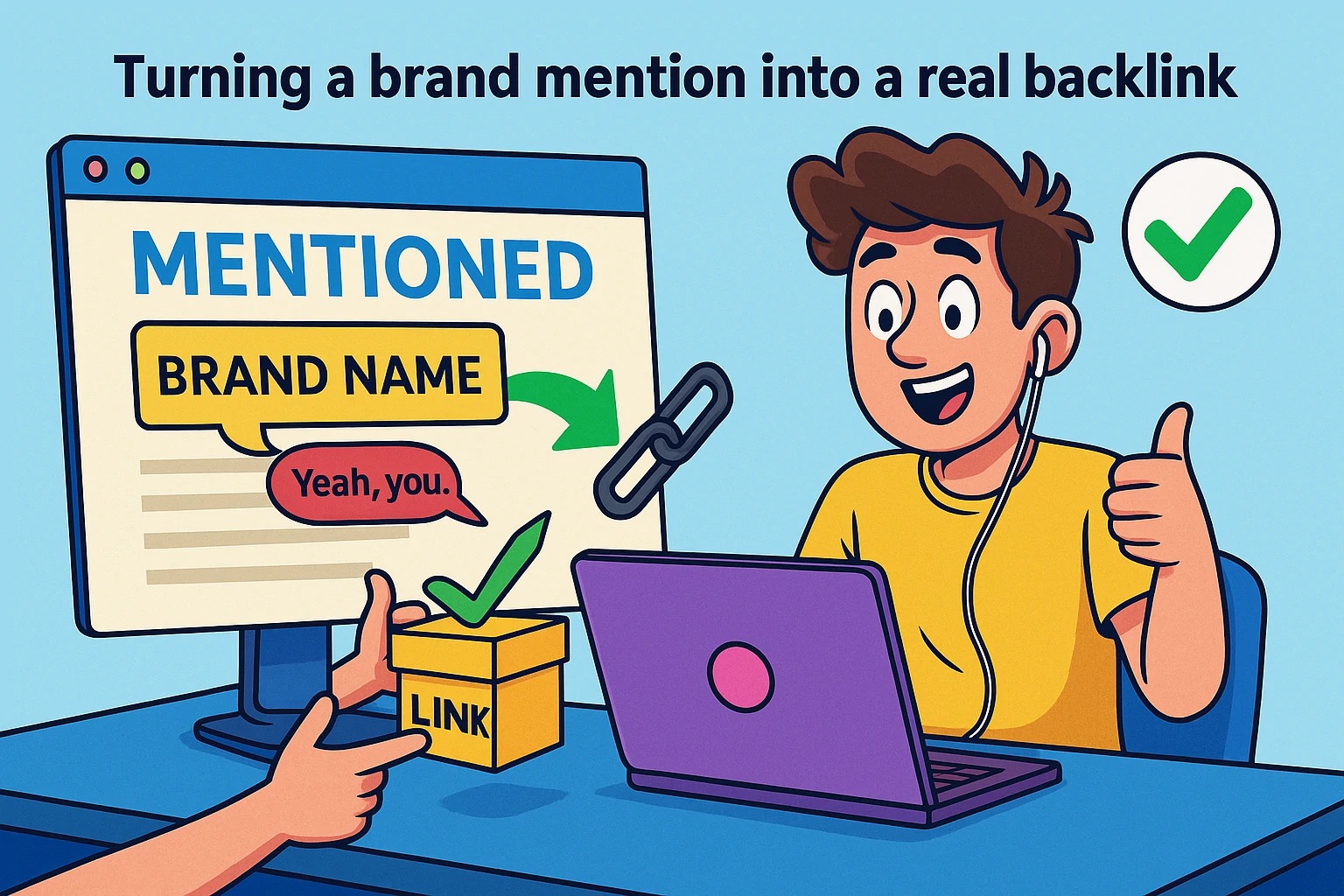
Brand mention? Turn it into a backlink – ninja-style!
Sometimes websites mention your name, product, or brand but forget to link to you. These are called unlinked mentions. You can turn many of these into real backlinks with a simple, polite request. It’s one of the easiest ways to earn links because the site already knows who you are.
Use tools like Google Alerts or SEO software to find pages that mention your brand. Look for your business name, website, or product. Visit the page and see if they included a clickable link. If they didn’t, check if the page looks active and relevant. Then find the contact info of the author or site owner.
Send a short email. Thank them for mentioning you. Let them know the article helped you. Then ask if they’d be open to adding a link to your homepage or related page. Keep the tone kind and low-pressure. Many editors will update the post. This builds links from places where your brand already has trust.
How Broken Link Building Works Step-by-Step
Broken link building helps other websites fix dead links and gives you a chance to earn a backlink. When a page links to a site that no longer exists, that link becomes useless. Editors want to fix those broken links, and you can help by offering your own content as a replacement.
Start with research. Use tools like Ahrefs, Screaming Frog, or Check My Links to find broken links on websites in your niche. Focus on resource pages, old blog posts, and list articles. Look for links that return a 404 error. Once you find one, check what the broken link used to show. Then match it with a page you already have—or create a new page that offers the same value.
Next, contact the website owner. Tell them you found a broken link on their page. Share the exact location and explain the issue. Then offer your content as a better option. Keep your message short and friendly. Many editors will thank you and swap the link. It helps them improve their page, and it helps you build a safe, white hat backlink.
Local SEO Link Building: White Hat Tips for Local Businesses
Local businesses need strong backlinks just like national brands. But the best links for local SEO come from nearby sources. These include local news websites, business directories, event pages, and area blogs. Each local backlink shows search engines that your business is trusted in your city or region.
Start with local directories. Add your business to trusted sites like Google Business Profile, Yelp, and local Chamber of Commerce listings. Make sure your name, address, and phone number match across all platforms. That improves your rankings in local searches.
You can also partner with nearby groups. Sponsor a school, join a charity event, or offer a free resource to a local publication. If your brand supports a good cause or helps the community, local media may feature you. That mention often includes a valuable link. Local blogs and niche city sites are also great sources of safe, white hat backlinks.
How to Recover from a Google Penalty Caused by Bad Links
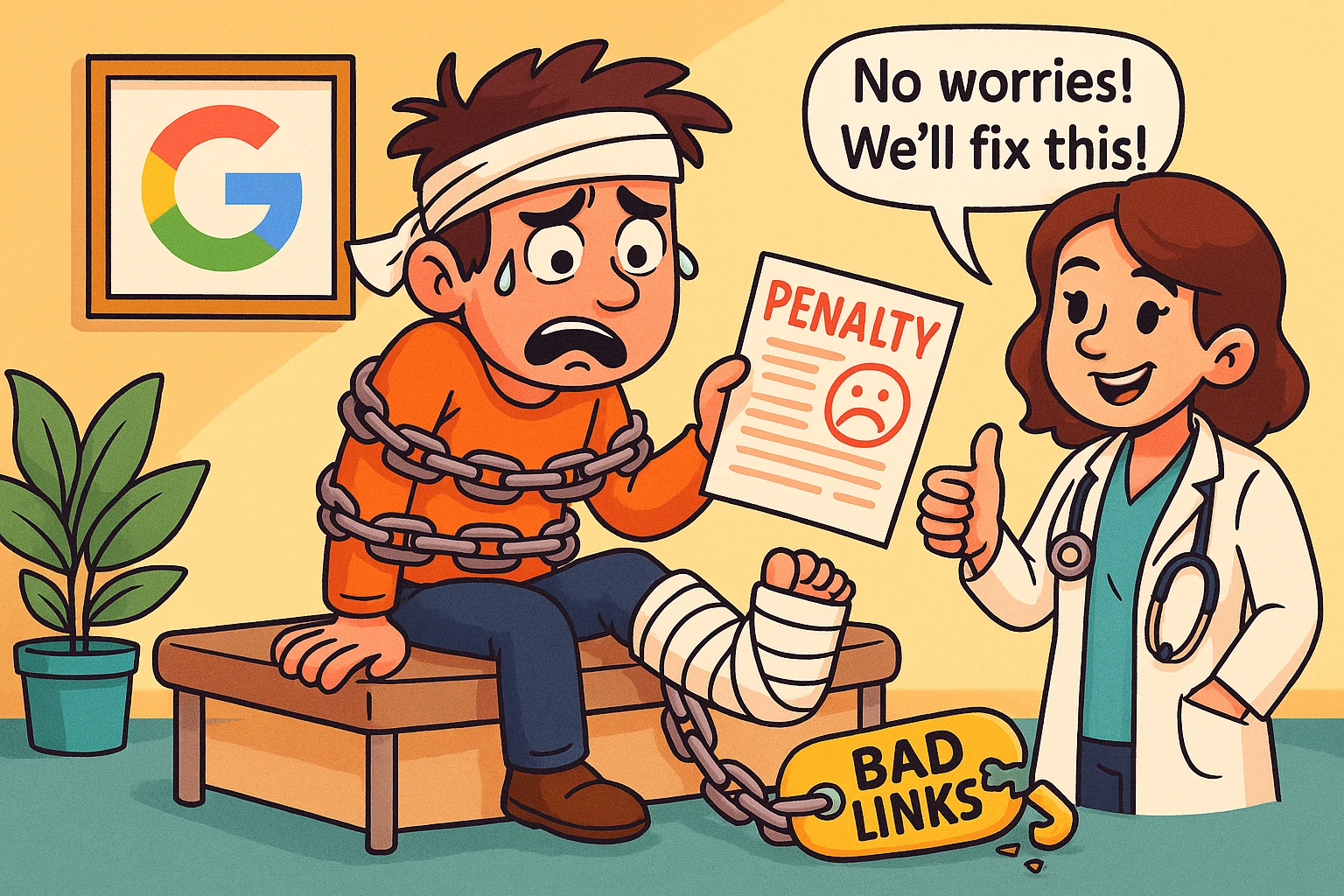
Google caught you? Time to detox your backlinks!
If your website has lost traffic and rankings after bad link-building, you may be facing a penalty. This happens when search engines detect shady or unnatural backlinks. Recovery is possible, but it takes time and a clean, white hat approach. You must act fast and follow a clear plan to fix the issue.
Start by checking your backlink profile. Use tools like Google Search Console, Ahrefs, or SEMrush to find every link pointing to your site. Look for links from spammy blogs, unrelated forums, or sites filled with ads and poor content. Focus on links that don’t match your niche or look suspicious.
Try to remove the worst links. Contact the site owners and ask them to take the links down. If they ignore you or you can’t reach them, use Google’s Disavow Tool. This tool tells Google to ignore those bad links. After that, improve your content and build new white hat backlinks. Over time, your rankings can return. Patience, honesty, and clean SEO are the only way back.
Can AI Help with White Hat Link Building Strategy?
AI tools now play a big role in digital marketing. They can also support your white hat link building strategy, if used the right way. AI does not replace effort, but it can speed up research, improve outreach, and suggest better content ideas. When used smartly, AI helps you stay focused on value.
Use AI tools to find good websites for outreach. They can analyze backlink gaps and spot trends in your niche. Some tools scan your competitors and show who links to them. This helps you build a target list faster. You still need to write real messages and connect with people, but AI gives you the data to do it better.
AI also helps with content planning. You can ask for topic ideas, outlines, or summaries. These tools won’t do the writing for you, but they help shape your ideas. Just make sure everything stays original, clear, and human. AI should guide, not replace. If you lead with value and support it with smart tools, your white hat strategy becomes even stronger.
How to Create a White Hat Link Building Calendar or Checklist
White hat link building works best when you follow a plan. A weekly or monthly calendar helps you stay on track. It keeps your actions consistent and focused. Instead of chasing random links, you build a steady flow of trusted backlinks.
Step-by-Step Weekly Link Building Plan
| Week | Task |
|---|---|
| Week 1 | Pick one strong page on your website to promote |
| Week 2 | Find 10+ websites in your niche that accept links or guest posts |
| Week 3 | Send polite outreach emails to editors or site owners |
| Week 4 | Follow up with contacts who haven’t replied |
What to Track in Your Link Building Checklist
- Website name and URL
- Contact person and email address
- Date of first outreach
- Status (no reply, accepted, rejected)
- Date of follow-up
- Link placement (published or pending)
- Page linked to (exact URL)
-
Anchor text used
Tips for Success
- Set a weekly goal (e.g., 5 new contacts, 2 follow-ups)
- Use a spreadsheet or Airtable to track every detail
- Review your progress at the end of each month
- Adjust the plan based on what works best
- Stay consistent, even one link per week adds up fast
Pro Tip
Stick to your calendar, even if the results come slow. White hat SEO rewards patience, not pressure. The key is quality over speed.
How to Begin Your White Hat Link Building Journey
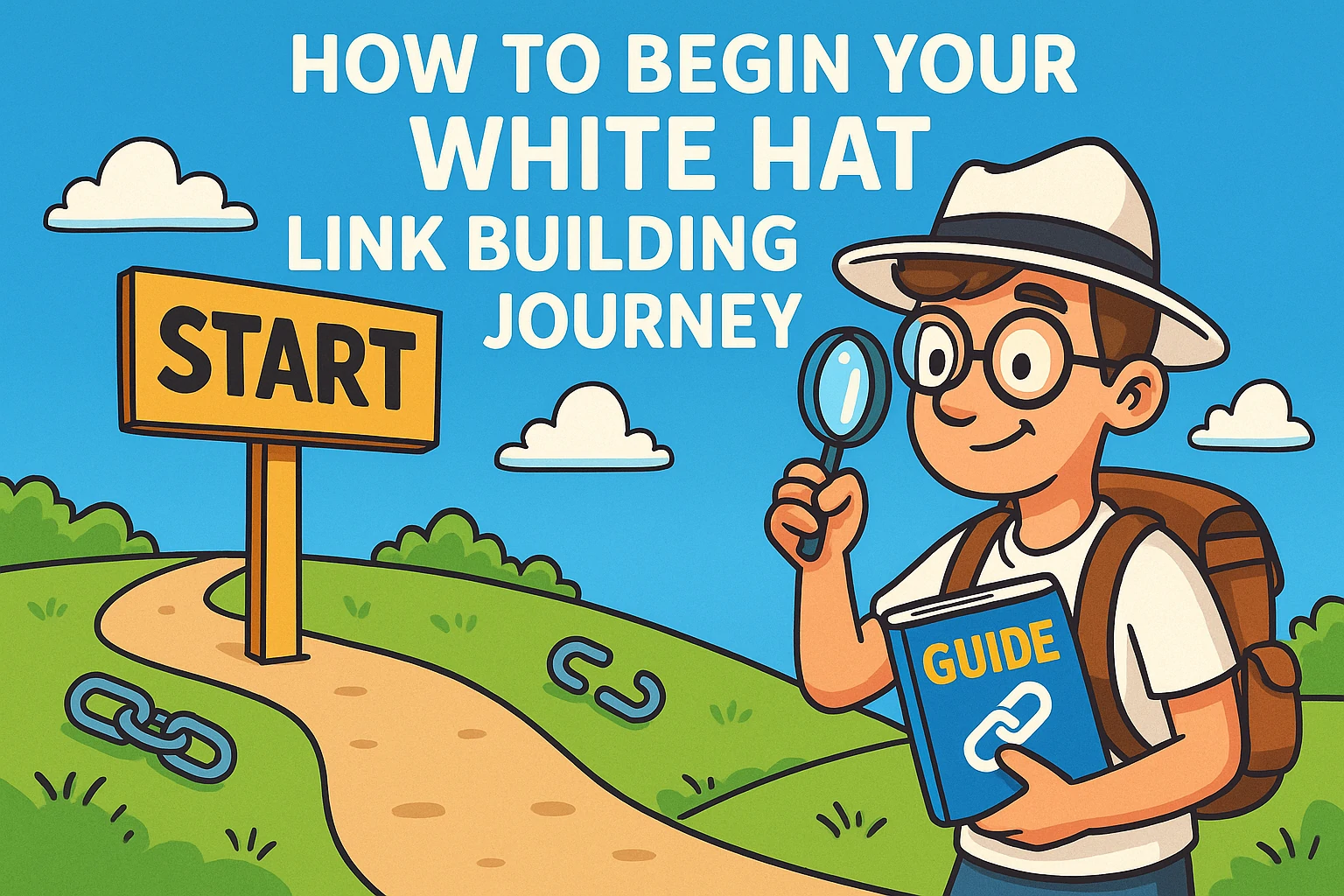
Starting your white hat journey like a knight on a laptop, ready to rescue SEO!
Start with a solid base. You need good content. Without it, no one will want to link to your site. Your content must help someone. It can solve a problem, answer a question, or offer a new view. Always create something others want to read or share.
After content, focus on research. Look for websites in your field. Choose ones with real traffic. Pick blogs, business sites, or media pages that post often. Avoid sites filled with spam, ads, or low-effort writing.
Next, reach out. Contact site owners or editors. Be polite and clear. Don’t ask for a link in your first message. Show interest in their work. Offer value. Mention your content only if it fits their audience. This builds trust.
Over time, build real connections. Share other people’s posts. Leave thoughtful comments. Mention their work on your own site. People notice. They return the favor. That’s how natural links grow.
Keep track of your results. Use simple SEO tools to log your efforts. Watch what works. Improve what doesn’t. Stay active and keep your outreach real. Over time, your efforts will pay off.
Smart Link Sources That Work Safely
Every good backlink starts with relevance. The best links come from sites in your field. These links help search engines understand your niche. They also drive better traffic to your site.
One trusted source is a guest post. You write a full article for another site. In return, you get a link in your author bio or within the content. This method builds exposure and earns solid links. Make sure the site is active and has clear standards.
Resource pages offer another great path. Many sites list helpful tools or guides for their readers. If your content fits their topic, ask to be included. This simple approach often works well.
Mentions from news outlets also help. Journalists need quotes, data, and experts. You can join platforms that connect writers with sources. Answer their questions. Share insights. If chosen, your site earns a link from a respected source.
You can also try broken link outreach. Look for dead links on websites in your niche. Then offer your content as a replacement. Site owners often thank you and update the page with your link.
Another strong option is original research. If you collect stats or create a new study, people will cite it. Use simple graphics to explain your results. That makes your data easier to share.
No matter which method you choose, keep it real. Offer value. Match your link to the topic. Stay relevant and honest.
Useful Tools That Support White Hat Link Building
White hat link building takes effort, but the right tools save time and keep your process clean. These tools help you track backlinks, find outreach contacts, and improve results step by step.
| Tool Name | Main Purpose | Key Benefit for Link Building |
|---|---|---|
| Ahrefs | Backlink research and competitor tracking | Shows who links to your site and reveals link gaps in your niche |
| SEMrush | SEO audits and link profile analysis | Monitors new and lost backlinks, anchor texts, and domain authority |
| BuzzSumo | Content research and idea generation | Finds top-performing content and influencers who might link to you |
| Hunter.io | Email finder for outreach | Helps you locate verified contact emails for guest post or pitch outreach |
| HARO (Help a Reporter Out) | Media link opportunities | Connects you with journalists looking for expert quotes and references |
| Google Search Console | Link performance and website insights | Tracks which backlinks bring the most traffic and alerts you to spam links |
| Screaming Frog | Site crawling and technical audits | Detects broken links and redirect errors that affect link quality |
| Moz Link Explorer | Domain authority and link metrics | Measures the strength and trust level of potential link partners |
Smart Tip
Use two or three of these tools together. For example, find opportunities with BuzzSumo, verify them with Ahrefs, and contact editors using Hunter.io. Combining tools saves time and keeps your backlink strategy honest and effective.
Mistakes That Can Ruin Your Efforts
- Do not buy links. Paid links break search rules and risk penalties.
- Do not use private blog networks. Fake networks harm trust and rankings.
- Do not spam comments or forums with links. This lowers credibility and brings little value.
- Do not publish low‑quality guest posts on weak sites. Those links add no value.
- Do not repeat the same anchor text on many links. That looks unnatural to search engines.
- Do not chase links from irrelevant sites. Relevance matters more than volume.
- Do not ignore link quality checks. Bad links can damage your profile.
- Do not send many follow-up messages. One polite follow-up is enough.
- Do not hide sponsored links or fail to label them. Transparency avoids penalties.
- Do not ignore your backlink profile. Monitor it and act when needed.
| Common Mistake | Why it Hurts | What to Do Instead |
|---|---|---|
| Buy links | Search engines penalize paid links. | Earn links with helpful content and real outreach. |
| Private blog networks | These networks appear fake and lower trust. | Target real sites with real audiences. |
| Spam comments/forums | Links here bring no traffic and harm reputation. | Add value in discussions and link only when relevant. |
| Low‑quality guest posts | Weak sites do not pass authority. | Guest post on respected blogs with real readers. |
| Repeated exact anchors | Looks like manipulation to algorithms. | Use varied anchors: brand, URL, and natural phrases. |
| Irrelevant links | They confuse search engines and users. | Seek links from sites in the same niche. |
| No backlink checks | You miss toxic links that harm rankings. | Review links in Search Console or Ahrefs monthly. |
| Excessive follow-ups | That feels pushy and burns relationships. | Send one polite follow-up and then move on. |
| Hidden sponsored links | Hiding sponsorship breaks rules. | Label sponsored links clearly or use no‑follow. |
| Ignore negative signals | Ignoring problems lets damage grow. | Remove or disavow bad links and build white hat links. |
How Different Industries Apply White Hat Link Building
Each niche has a unique path to earning links. One method may work well in tech but fail in fashion. You must adjust your approach to fit your field.
Local businesses can build links with area groups. Join local business directories. Support events. Sponsor school teams. These links are easy to earn and build community trust.
E-commerce sites can offer product reviews or guides. Reach out to bloggers who cover similar items. Offer free samples in exchange for an honest review.
Health and wellness brands must stay accurate. Share expert tips or verified research. Connect with blogs in fitness, diet, or mental health. Offer help, not hype.
Tech companies can build tools or tutorials. Share them on GitHub or developer forums. Write blog posts that show how your product works in real life.
Education sites can create resources for teachers or students. Lesson plans, study guides, and quizzes can attract schools and learning blogs.
Finance and law firms should write clear and honest guides. These must be accurate. Reach out to respected media or government pages. Show your knowledge through content.
Match your strategy to your audience. Speak their language. Offer what they need. The links will come naturally.
Final Thoughts
White hat link building takes patience. It does not chase hacks. It builds real value over time. This strategy earns trust from Google and real users.
You don’t need to rush. One helpful article and one honest backlink can do more than a hundred shady shortcuts. Quality wins in the long run.
White hat tactics protect your brand. They grow your site with clean links and strong outreach. That growth may take time, but it lasts.
Start with one step. Reach out to one site. Share one useful resource. Then keep moving forward. Each step adds power to your SEO.
Search engines respect honest work. Readers do too. When you build with purpose, you win both. That’s the real strength behind white hat link building.


